#fasting blood sugar normal range
Explore tagged Tumblr posts
Text
"Just a naïve one arent ya?"
=HOSHINA SOSHIRO



Ive had brainrot of this man for the whole days.. also some karasu brainrot.
18+ NSFW. EXPLICIT.
MARKING/BITING, OVERSTIMULATION,P IN V, SLIGHT BONDAGE? BLOOD,INJURY! ,W/PLOT,RAW!,HAIR PULLING, FEM READER!,BOTH PRAISE?, DEGRADE?,RIDING

the vice captain of the third division of the defense force, hoshina soshiro.
Or hoshina fuku taichō.
You were just a normal officer, serving also for the defense force and also in the third division.
You've always admired the vice captain from afar, well he has only greeted you once.... maybe thrice? We dont know.
The kaiju alarm has rang, waking the others up and moving quickly getting ready.
All of you moved fast to reach the vehicle in time. Others are now inside the vehicle, to reach where the kaiju is now attacking. You, also inside the vehicle and took a deep breath and exhale it, You look around inside the vehicle and it stops into the destination on where the kaiju is close, but not close enough to injure all of you inside the vehicle. All of you went outside the vehicle, readying you're guns
Pew pew.
There he was, wearing his armour, and also his double swords noticable,his closed eyes and the mask covering his mouth.
You grip ur gun tighter as the ground rumbles a little bit, due to the kaiju being hella big...
You prepare too shoot incoming kaijus, reloading freezing rounds to slow some of them up.
It was untill one attacked you from behind. As it attacked you, you managed to shoot it off and run away, hiding in a building gripping your bleeding shoulder.
Shit, those kaijus we're fast as fuck.
Your eyes slowly close due too the exhaustion from the blood lost.
But, you suddenly randomly woke up in a bed blah blah blah..
"Oh? Yer' awake! Didnt notice that." hoshina says with his signature smile and closed eyes of course...
Wait did you say hoshina?
ITS HOSHINA.
He sits on the chair beside you as you look at him.
"Uhm.." you say letting out a sound, well not entirely a sound but you dont know if its a word.
He flicks your forehead
"Ow.." you rub the place where he flicked you're forehead
"You're just a naïve one arent ya?" He says, looking at you while laughing " we found you bleeding inside of a random crumbled building, Ya coulda' been injured more!" He says while crossing his hands.
"Im.. sorry vice captain i had no where to go.." you say while sighing and also sweat dropping
"No, no its fine! You could repay me because i saved yer' life." He says while smirking at you.
"What.. kind of repayment..?" You say, swallowing the saliva thats been building up inside ur mouth.
"You'll see." He says while smiling, striking you with his signature smile.
NSFW AHEAD.
And thats how you ended up having your hands tied to ur back while riding your vice captain.. raw
"Yer' doing so well hm? Riding my cock like a fucking slut." He says, gripping your waist like hes holding on for dear life.
"Ah - ah- yes vice captain!" You say, tears welling up in you're eyes as the overstimulation consumes your body.
How many orgasms has it been? Two or three? Maybe even four.
You were slowly turning dizzy from the pleasure, no his pleasure That you were giving him.
He slowly makes his way into ur neck, feeling his warm breath.
He bites down a mark and it makes you arch your back and moan, he was still bouncing you up and down, like a fucking cocksleeve.
"I bet ya like this hm? Sugar?" He says, licking the mark, blood seeping from the mark.
"Y-yes Vice captai- AH!" you say, he moves ur body faster on his cock, there was a ring of white forming on it, due to the past orgasms.
Goddamn this man had a lot of stamina...
Well of course? What would you expect from the vice captain?
He pulls ur hair for a kiss, intertwining your tongues together, he was kissing you like a starved man.
While he was kissing you, his hands slowly made it into your clit, rubbing it in tight cirlces.
He breaks the kiss and opens his eyes. You saw his red eyes staring at yours.
"C-cant do it haaah..." you say feeling exhausted from bouncing on his cock.
"You can do it, just one more... one more.." he still kept rubbing circles on ur core, he was feeling you tightening on his shaft.
He felt good from all of this.
"C-coming!" You say.
"Come. Now." he says making you bounce more faster on him.
"Ngh- aahha!" You came, oh so deliciously on him,he soon followed after you.
You were both panting and huffing.
"Who said we were done yet?"

Hes so ooc for me.. AGGGHHHHH
#hoshina smut#hoshina soshiro#hoshina soshiro x reader#hoshina x reader#soshiro hoshina#kn8 smut#kn8#kaiju no. 8#kaiju no. 8 smut#kn8 x reader#<miyakiwi>#hoshina soshiro smut#soshiro smut#kaiju no.8 x reader#kaiju no. 8 x reader
1K notes
·
View notes
Note
I go you already have my apologies but can you re explain your ideal bird that you are breeding for. From the looks of your loft updates you prefer standard non exaggerated features and minimal muffs and normal length beaks
No worries. ^v^
I've been reworking a few things while we've been stuck on hiatus, so there have been some changes to the plans for the future, and I don't mind going over them.
I am trying to develop a unique breed specifically for therapy work.
As many of my long term followers know: A feral pigeon, found in a parking lot on the brink of starvation, taught himself to alert me for anxiety attacks of crippling severity.
If he could not alert me fast enough to prevent me going catatonic, he knew to go get my husband.
And he worked out a series of behaviors to draw me back out of that state if my husband was not with me.
He later developed an alert specific to blood sugar spikes.
That's far beyond the scope of an Emotional Support Animal!
And I believe that if a pigeon off the literal street was naturally inclined to develop these behaviors, then temperament traits conducive to such service work can be selected for.
I aim to do that by combining highly intelligent Performance breeds like Homers, Rollers, and Tumblers with structurally sound exhibition breeds possessing a demonstrably heritable mellow temperament.
And I want this breed to have a unique look that easily identifies it so that it will be hard for feather merchants to counterfeit. (Yes, that is a thing that happens.)
So, my favorite embellishments in the breeds we are already using are going to be enhanced by a few exhibition breeds who exemplify those traits, and one specifically for color.
To that end, we will be utilizing these performance breeds:

Feral
I can get into whether or not this is a breed in itself in another post. This is going to be a long one as it is.
There are several risks to working with ferals, absolutely.
You can pretty much guarantee that any you may find have lice, one or two species of worms, at least two protozoan parasites, and could potentially have a whole host of other bacterial or viral pathogens with out showing any outward sign.
Anyone who works with ferals as a first responder must be prepared to quarantine them carefully, vaccinate them, and test them to find out what all you will need to treat.
But there are three huge advantages for the Assistance Pigeon Project:
They are the epitome of structural soundness. That slight, agile little body has come to be through surviving generations of environmental pressures from having to travel long distances to find food to having to dodge a wide range of predators like cats and hawks.
There is no better source of intelligence than the descendent of birds that have survived for generations on their wits and luck alone.
And no better source of an excellent immune system than the result of generations living with the host of parasites and pathogens that they are so often loaded down with in the wild. There is a reason you won't see any outward sign that a feral has anything!
Once a feral's parasites and pathogens are cleaned out, they are incredibly sturdy!
Being a domesticated animal, the offspring of ferals in human care tend to focus all the inquisitive brightness that kept their line alive in the wild on bonding and communicating with their care taker.
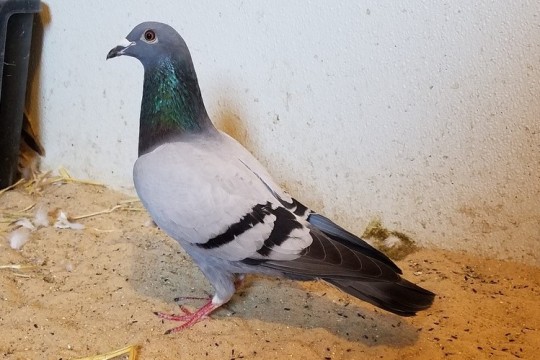
Racing Homer
The thoroughbred of pigeons.
If you do not count Ferals as a breed, this is the most structurally sound and intelligent of all pure breeds.
Hands down the single most athletic!
They are stockier, more aerodynamic, and far more muscular than the average feral, because they were bred to be able to find their way home from drop points up to and over 500 miles away.
It takes not just fine tuned musculature and metabolism, but an excellent memory and keen intelligence to adapt on the literal fly to the changes in environment and predator populations over such distances.
Because of their exposure in races to hundreds or even thousands of other birds from lofts all across the country, Racers also have the strongest immune system of any purebred.

Birmingham Roller
This is not a breed that flies long distances like Racers or Ferals, but as a performer, it is still required to be structurally sound.
Performances consist of flying in a small flock called a Kit to perform a waterfall effect of staggered rolls where birds backflip 15-20 times in a row in midair, straighten from the roll, and rejoin the kit, one after another.
They are less flighty than Ferals and less independent than Racers, typically working much more closely with their trainer: keeping within sight of the loft and earshot of the person.
This makes them a little more human focused and naturally inclined to be biddable.
Though many traits vary wildly by line, these tend to be very small birds; energetic, jaunty, and playful.
Aside from adding that wonderful temperament, they will help keep the end result small.

Portuguese Tumbler
I waffled on these for quite a while, mostly because of their very small size and absolute breeding overdrive.
But they are excellent parents despite being the second smallest breed of pigeon in the world, and, unlike the Valencian Figurita, generally don't need one of their nestlings fostered.
And that speaks very highly of just how physically fit they are.
There are a few big breeds among the ones selected specifically for temperament, so Ports and Birms should help bring the size down and improve the parenting ability of the blend.
But the real push was just how Exuberantly friendly and playful this gleeful little breed is!
There are two performance breeds I have no hands on experience with yet that I would like to add:

Oriental Roller
This one is a dual purpose:
Once again, a structurally sound bird of moderate build, because it is still flown in competition.
But what interests me is the tail.
This breed is one of the major components of the Mindian (Miniature Indian) Fantail, Bred to Indian Fantails too small to compete with in order to improve the structural soundness and preserve the fan.
And as one of the embellishments I want in this breed is a slight fan, this body type is ideal to help display it comfortably.

Turkish Takla
The Takla is a Roller breed, still flown in competition, and becoming popular in the US for its docile, biddable temperament.
It comes with or without crest or muffs, and I very much like the grouse muffs of this breed.
We'll have to see what the temperament is really like, but the bird is gorgeous, and I expect it will blend well in terms of structure, temperament, and moderate embellishments that are still eye catching.
Breeds selected for temperament:

Show Line Danzig Highflier
This breed is the single best investment I have ever made towards the temperament of my breeding flock!
They are intensely friendly! Every bird I have raised with any amount of Danzig in them has gone on to be a beloved cuddle bug of a pet.
My Husband's ESA, Cotta, is the closest we have gotten so far to the behaviors we want in a bird bred for Service work.
Not only is he my Husband's devoted ESA, he also acts as mine when I need regulation, and even Cheeto's when he struggles with impulse control or obsessive behaviors.
Cotta is so intensely human focused that he has organized Cheeto and another bird who was only with us temporarily to provide me aid during a very severe episode of vertigo.
That temperament has passed so reliable through Satin's family that I would have to be an idiot not to incorporate this breed.

Frillback
A shockingly mellow breed!
And not just because they could only be less aerodynamic if you gave them parachutes..
A great test to rule out learned helplessness being the root of any big or showy breed's apparent mellowness is to cross them with a smaller breed that flies well so the offspring will be more maneuverable than the big or highly embellished parent.
If the offspring that can physically evade you is flighty and nervous by nature, then the "mellow docility" of the parent is just learned helplessness.
But if that more maneuverable offspring is just as docile and tractable as the parent, then you can be pretty well assured that that really is the parent's temperament.
Frillbacks fall so soundly into the "genuinely that sweet tempered" category that it has passed on into multiple generations of my flock.
I won't use this breed much, because the curls are a little much and it's hard to find clean legged birds or lines with only moderate muffs.
But their temperament is so fantastic that it would be remiss of me not to use them at all.

Lucerne
This elegant Swiss breed borders on too mellow for its own good.
There are lines with peeps so quiet that they fail to trigger the parent's feeding response. Paired with another breed, though, even completely oblivious Lucerne will respond correctly once they see their mate feeding.
My first pair, despite hating me with the fury of a thousand suns, were so perfectly tractable that working with them was a breeze.
Some of my most out going individuals are crossed with this breed.
I love their structure and their very moderate Grouse muffs.
They have a shorter beak than I like, but it's long enough to be functional, and the other breeds will keep the beak from getting too short.

Show Type Racing Homer
This is another show breed famed for their docility.
While it isn't as absolutely incredible as the breeds higher on the list, I will be incorporating them for their very simple, elegant structure, and bold, out going curiosity.
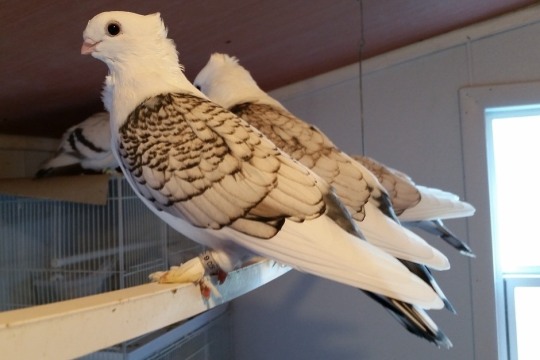
Classic Old Frill
This breed is somewhat of an indulgence, I admit.
Of the breeds included for temperament, this is the one most likely to be flighty or skittish.
But I have such a deep and abiding love for what they are: A return to form to the original standard of the Turkish Hunkari from the now beakless Modern and Oriental Frills.
Basically, the avian version of the Retromops (If you love Pugs, you should look this breed up. It's a return to the original standard: a pug with a muzzle, that can breathe normally and regulate its body temperature.)
This breed was my first love, and I want to continue to support the breeders that loved them enough to write preventative measures into the breed standard requiring that their beaks never get so short that they can't feed their peeps unaided.
There is one other breed I want to add for temperament entirely because of the temperament of mixed progeny I have purchased for the breeding program:
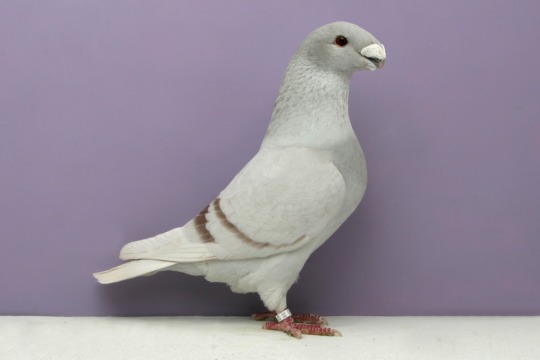
American Show Racer
Titan and her Mother, Ibis, take very strongly after their ASR Grandmother/Mother, respectively.
Ibis was so friendly and outgoing on arrival that I was sorely tempted to keep her as a personal pet instead of having her join the breeding flock.
Titan, despite being very defensive when she was little, grew up to be so much like her mother it takes my breath away.
I am curious to see if this breed is really that sweet tempered and it really passes so reliably, or if Ibis and her line inherited their temperament from the Lucerne side.
There are only two breeds added purely for their embellishments:

Old Dutch Capuchin
I love the Danzig's mane, and I think a little touch of ODC will add some luxury to it.
My experience with this breed was not the best temperament wise, but I have read that not to be the norm and hope to have better luck with a different line.

Garden Fantail
This is the most structurally sound of all fantails, able to fully close the fan when not displaying to fly and walk comfortably.
I do not want a full fan in this breed, but Fans seem to be a partial dominant with variable expression, if my two half fantails,
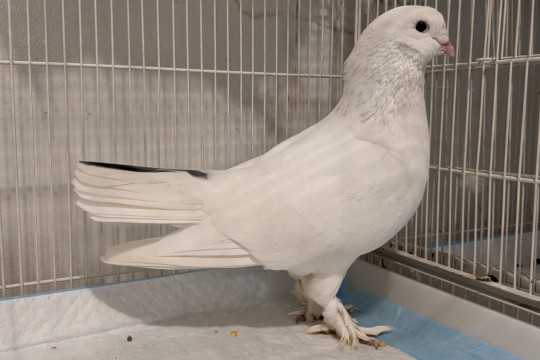
Sher and

Soiree, are any indication.
Not a necessity, by any stretch, but I really like the look of a moderate fan.
Finally, there is a single breed I plan to incorporate for color.

Archangel
There are exactly two traits I want from the Archangel:
The dominant half of its bronzing, which results in a robin like rusty breast in heterozygous form
And the intense sheen of its recessive grease quill.
With luck and patience, I hope for these nine breeds; six for performance, six for temperament, two for embellishments, and one for color...
Add up to a healthy, long lived Therapy breed whose intelligence is not blunted by their laid back mellow docility and whose unique look sacrifices none of their structural integrity.
The breeder cap will remain at ten pair, hatch controlled between evaluation periods.
Babies will be evaluated for six months.
If neither is an improvement over one or both parents, both will be classed as pets and adopted out.
If one is an improvement over which ever parent fits the program the least well, or better yet the ideal blend of their parents beneficial traits, then that one will stay, the parents will retire and go up for adoption as a bonded pair, and the sibling will be made available to the public.
New blood will come in to improve what ever trait is most lacking after each evaluation period.
Offspring we produce may become available at younger than six months once the temperament I want is reliably consistent.
But I expect that to take a fair few generations.
42 notes
·
View notes
Text
So I had my blood tested yesterday and results were hmmmm not really alarming but my fasting sugar is 2.49 and the normal range is 3.50 to 6.40. Last year, my sugar was also lower than normal but not this low
Survey: should I start getting worried? 😅
21 notes
·
View notes
Text
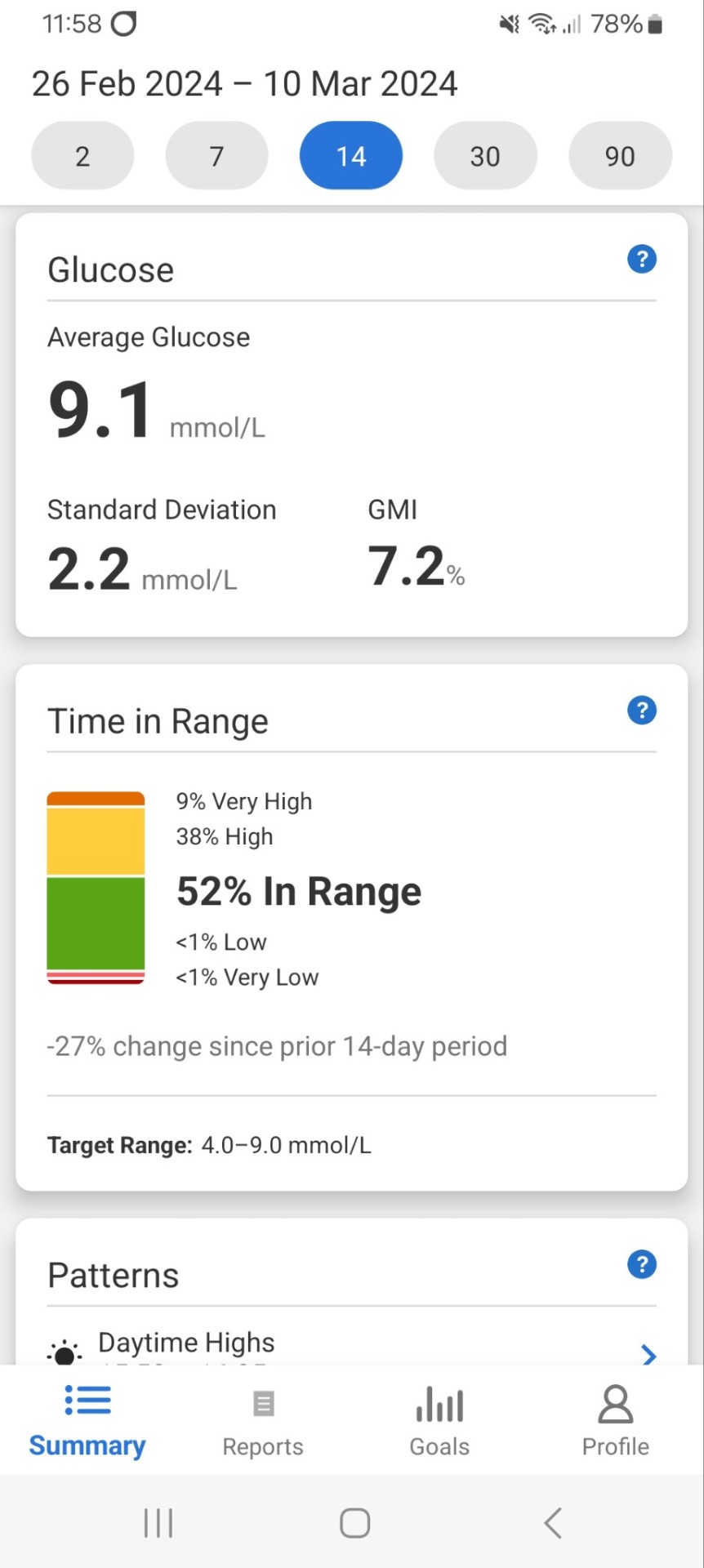
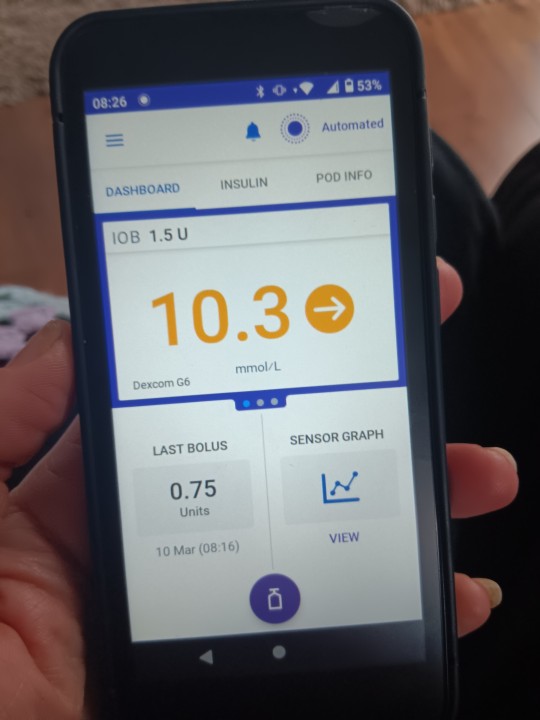
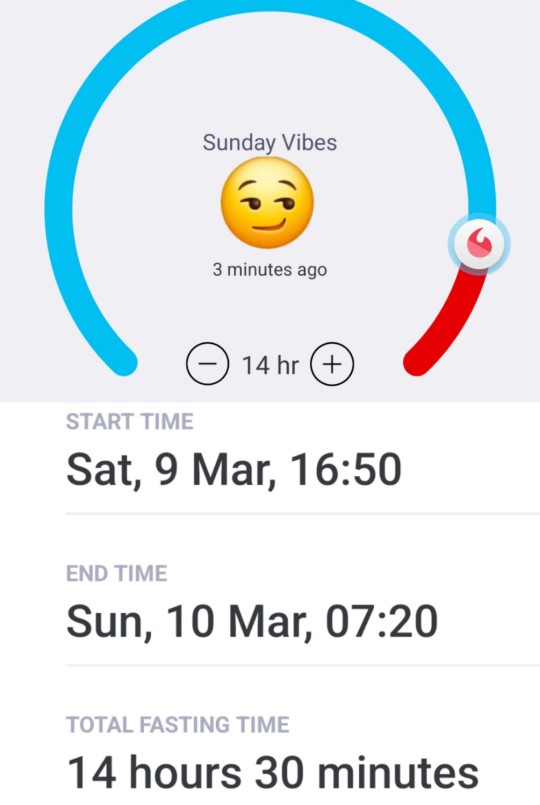


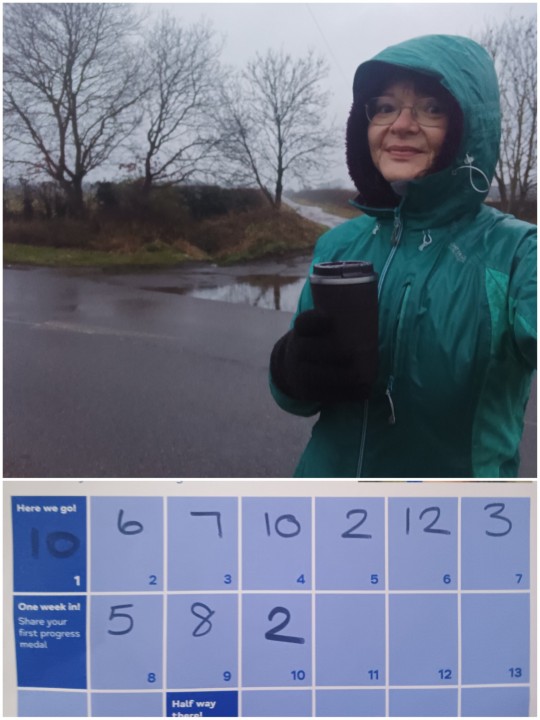

It's a pretty yucky day, which matches me right now, lol.
Just doing the best I can until I'm back into the motivation mojo.
Tired in mind, body and spirit, but absolutely sure of the fact of it being a temporary glitch.
Not so good. But I'll get better as soon as my blood sugars start behaving. Willing the pod/CGM loop to finally catch up to how my body works, so I can feel normal again.
Before this, I was in range 75-80% of the time on average. This ain't good.
But....still trying to hold my patience.
After a short two miles in the rain this morning, I'm now 65 miles into my 100 mile charity challenge goal so far.
I also did a half hour resistance band training session with one of my online clients.
I've stuck with a half decent fast time and good food as always, and I'm just giving myself self care for the rest of today.
Heading back over to the homestead to see family. Most importantly, my three boys.
Treated myself to a cappuccino for the journey.
First proper hit of caffeine for a while!
#typeonediabetes#suzieb-fit#highbloodsugar#type1diabetes#recovery#coffee#nutrition#healthy nutrition#costa
7 notes
·
View notes
Text
Hey y'all another "I suspect this is atypical but idk how atypical" question, this time about blood sugar! Okay, maybe a few questions
if your blood sugar is in the fasting blood sugar range, but you aren't fasting, does that count as low blood sugar?
2. Is it normal to have low blood sugar symptoms at not-technically-low-blood-sugar levels (today, 93)? Like, especially when it's that way when you have not been fasting, but also in general
3. How do you word "hey doc my records say you took my blood sugar when I was fasting, but I wasn't fasting. That was like an hour, hour and a half after lunch and I'd downed half a gatorade before I walked into the office and my blood sugar was in the 80s. Is that...maybe...a problem? That it's happened twice?" in a way doctors will care about?
#the person behind the yarn#medical mention#I make sure I have protein and complex carbs and eat smaller meals more frequently#but - wait I think I figured it out#well. why it's happening again now not why it happens in general#usually I have this under control but after I have an allergy flareup I'll be off kilter for days to weeks#depending on the severity of the allergic reaction#but like three times in the last two days I've been on the edge of a stress-induced allergic reaction and haven't needed a benadryl#so maybe it got close enough to disturb my blood sugar???#my endocrine system is all fucked up and I know that can impact blood sugar#fun side effect I only figured out a week or two ago:#apparently sometimes low blood sugar can trigger a release of some adrenaline#which I did not know because my body kinda...did not have any extra adrenaline#but now I am on corticosteroids so I DO have some reserves#and it means I get high blood pressure when I get lowish blood sugar which has not happened for me in the past#so that's. something. probably good??? to be able to have noticeable adrenaline reactions to things???? but not fun
7 notes
·
View notes
Text
Blood work results
I got my first set of bloodwork results. Things look good, though I am concerned about my insulin/blood sugar and male sex hormones (I'm a woman).
My insulin and blood sugar levels are within the normal range, but high-normal. Same with a lot of my androgens and androgen stimulating hormones. I have elevated testosterone levels (not too high, just a bit). I'm concerned that I may have insulin resistance or PCOS. My sister has both conditions. Though after my annual woman's health exam, my doctor said everything looked fine. Also my lipid panel looks great, and these are elevated in women with PCOS.
I have low levels of some omega-3 fatty acids, but I've switched to fish oil which contains them, unlike flaxseed oil. Even my thyroid hormone levels went down compared to my last test. I wonder why.
I absolutely know for a fact that I've recently been overweight. And definitely stressed. I've been implementing intermittent fasting for 4 months. I have lost weight and I am convinced I have more to lose. If these are the results that appeared on my bloodwork, then it's an indication that I need to lose further weight. Type 2 diabetes runs in my family, so I don't want to experience that and due to the predisposition, I need to maintain that low/normal body weight, do IF, and eat well. I was pretty slim in 2018, but I had an ED. I want to go back to a similar body weight but with IF and balanced non-restrictive eating as opposed to calorie and food restriction.
In 2021 I did blood work and my glucose levels were fine. I was eating a lot of sugar and junk and was stressed and in an awful mood and had poor sleep, though I was active and in slim shape. I know stress and sleep and physical activity do play a role in insulin and blood sugar issues and not just eating a lot of sugar and carrying extra weight. I know walking helps a lot too. I do need to work on my stress though. With all of the news from Gaza and my terrible eczema I got much more stressed. I'm sure the stress made my eczema worse and it was awful this year. I don't recall my eczema being as bad in 2021 though. I wonder if there's a hormonal link to eczema now that I think of it. And my sleep is better now, thankfully.
All I can really do is to continue IF, continue to shed more fat, manage stress, continue my good sleeping habits, continue to walk a lot, and don't eat a lot of sugar and junk (my diet is better now, thankfully). Perhaps some supplement ingredients can also help, like chromium, berberine, and inositol. I'm very happy with my D3/K2 and magnesium and now my fish oil supplements. I'm going to find a go-to multivitamin that can help with my hormones if possible, and a go-to gut health supplement that can help with my gut issues I discussed yesterday. I read a scientific publication that illustrates a link between intestinal permeability and insulin resistance. It would not surprise me that gut issues can cause hormonal imbalances such as what I'm seeing. And increased testosterone can be caused by insulin sensitivity/elevated blood glucose (not necessarily with PCOS which I've never received a diagnosis for).
The goal is to lose fat and to reduce my stress, and to continue the IF, good sleep, and healthy eating habits. Eventually I will find a go-to multivitamin that can help with my hormones and a go-to gut health supplement which can help my gut and in turn, my eczema and hormonal issues.
2 notes
·
View notes
Text
What Is Hyperglycemia? Causes, Symptoms, and How to Manage It
Hyperglycemia simply means high blood sugar. The word comes from "hyper" (too much) and "glycemia" (glucose in the blood). While it’s most often linked to diabetes, hyperglycemia can also occur due to stress, certain medicines, or illnesses.
If not managed properly, high blood sugar can lead to serious health issues, especially for your eyes, kidneys, nerves, and heart. That’s why understanding its signs, causes, and management is so important—especially if you're living with diabetes or at risk.
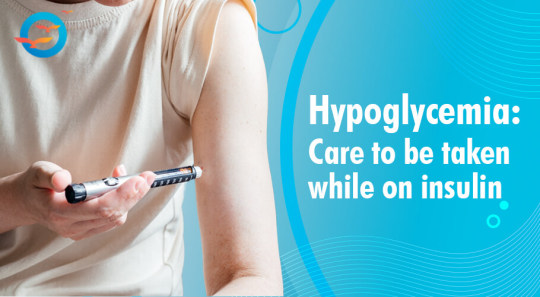
What Are Normal and High Blood Sugar Levels?
Knowing your blood sugar range helps you stay in control. Here's a quick guide:
Normal fasting glucose: 70–99 mg/dL
Prediabetes (fasting): 100–125 mg/dL
Hyperglycemia (fasting): 126 mg/dL or higher
After-meal hyperglycemia: Over 200 mg/dL (2 hours post-meal)
Staying within these limits can prevent long-term complications.
What Causes Hyperglycemia?
High blood sugar can happen for several reasons. The most common causes include:
Lack of insulin, insulin resistance, missing medication, overeating (especially carbs), lack of exercise, illness or infection, mental or physical stress, and steroid medications.
Common Symptoms of Hyperglycemia
Some signs are easy to spot. Watch out for:
Frequent urination, increased thirst, blurred vision, tiredness, dry mouth, unexplained weight loss, nausea, or confusion.
If symptoms are severe or ongoing, it could lead to conditions like diabetic ketoacidosis (Type 1) or hyperosmolar hyperglycemic state (Type 2)—both medical emergencies.
What Can You Do About It?
Managing hyperglycemia is all about keeping your sugar in a safe range. This includes:
Eating healthy, staying active, drinking enough water, monitoring blood sugar regularly, taking your medications as prescribed, and talking to your doctor if levels stay high.
Final Thought
If you feel unwell or notice symptoms of high blood sugar, don’t ignore them. Get your blood sugar checked and talk to your doctor. With the right steps, hyperglycemia can be managed—and even prevented.
Read more about this, visit our blog.
https://www.freedomfromdiabetes.org/blog/post/what-is-hyperglycemia/4513
#Hyperglycemia#high blood sugar#signs of high sugar#causes of hyperglycemia#how to manage blood sugar#diabetes and high sugar#what to do if sugar is high#normal blood sugar levels#sugar levels after food#prediabetes vs diabetes
0 notes
Text
Total Guide to Phlebotomy Tests: Understand the Processes, Preparation Tips, and What Your Results Mean
Complete Guide to Phlebotomy Tests: Understand the Processes, Readiness Tips, and What Your Results Mean
If you’ve ever been asked to get a blood test or are considering one for health reasons, understanding the process can feel overwhelming. Phlebotomy tests are vital diagnostic tools used to assess your health, detect diseases, and monitor ongoing conditions. This thorough guide aims to demystify phlebotomy tests,explaining how thay are performed,how to prepare effectively,and what your lab results mean.
What Are Phlebotomy Tests?
Phlebotomy tests are diagnostic procedures involving the collection of blood samples from patients to analyse various health markers. These tests help doctors evaluate everything from blood sugar levels to organ function, detect infections, and diagnose medical conditions.
Why are Phlebotomy Tests Vital?
Diagnose diseases such as diabetes, anemia, or infections
Monitor chronic conditions
Determine the effectiveness of treatments
Screen for certain health issues before symptoms appear
Common Types of Phlebotomy Tests
Below is a list of frequently ordered blood tests:
Test Name
Purpose
Complete Blood Count (CBC)
Assess overall health, detect anemia, infections, and more
Lipid Profile
evaluate cholesterol levels and cardiovascular risk
Blood Glucose Test
Diagnose diabetes or hypoglycemia
Liver Function Test
Check liver health and detect liver diseases
Thyroid Panel
Assess thyroid function and diagnose thyroid disorders
The Phlebotomy Process: Step-by-Step
1. Preparation Before the Blood Draw
Before your phlebotomy test, your healthcare provider or technician will give specific instructions, which may include fasting, avoiding certain medications, or hydration strategies. Proper preparation ensures accurate test results.
2. The Blood Collection Procedure
The process typically involves the following steps:
Identification: Confirming your identity to ensure the correct sample collection.
Site Selection: Moast commonly,blood is drawn from a vein in your arm,usually inside the elbow or back of the hand.
Cleaning: The site is disinfected to prevent infection.
Tourniquet Submission: A tourniquet is tied around your upper arm to engorge the veins.
Needle Insertion: A sterile needle collects blood into a vacuum tube or syringe.
Sample Handling: The collected blood is labeled and sent to the lab for analysis.
Post-Procedure Care: Applying pressure and a bandage to stop bleeding and prevent bruising.
3. After the test
You can typically return to normal activities instantly, though staying hydrated may help with recovery from minor bruising. Results are usually available within a few hours to a few days, depending on the tests ordered.
preparation Tips for Phlebotomy Tests
Proper preparation helps ensure the accuracy of your test results. Here are practical tips:
Follow fasting instructions: For blood sugar or lipid profile tests, fasting for 8-12 hours is often required.
Stay hydrated: Drinking plenty of water can make veins more accessible.
Avoid certain medications: Inform your healthcare provider about any medications or supplements that may interfere with results.
Wear appropriate clothing: Sleeves that can be easily rolled up make the process smoother.
Relax: Staying calm can reduce vein constriction and improve the success of blood draw.
Understanding Your Phlebotomy test Results
receiving your test results can be confusing. Here’s a quick guide to understanding common outcomes:
Normal vs. Abnormal Results
Test results typically come with reference ranges. Values outside these ranges may indicate health issues requiring further examination.
Parameter
Normal Range
What Abnormal Means
Hemoglobin
13.8-17.2 g/dL (men), 12.1-15.1 g/dL (women)
Anemia, bleeding, nutritional deficiencies
Cholesterol
Total: < 200 mg/dL
High levels may contribute to heart disease
Blood Glucose (Fasting)
70-99 mg/dL
High: Diabetes; Low: Hypoglycemia
What to Do After Receiving Results?
Discuss with your healthcare provider for interpretation and next steps.
Follow recommended lifestyle changes or treatments if results are abnormal.
Schedule follow-up tests if necessary.
Benefits and Practical Tips of Phlebotomy Testing
Understanding the benefits of blood testing can encourage proactive health management. Here are some advantages and tips:
early detection: Spot health issues before symptoms manifest.
Monitoring health: Track chronic conditions effectively.
Personalized care: Guide treatment plans based on specific markers.
Practical tip: Keep a health journal to track symptoms and test results over time.
Real-Life Case Study: Managing Diabetes with Blood Tests
The Situation
A 45-year-old man noticed frequent urination and fatigue. His doctor ordered a fasting blood glucose test.
The Test & Results
The fasting blood sugar was 130 mg/dL,higher than normal,indicating possible prediabetes.
The Outcome
Based on the results, lifestyle modifications, including diet and exercise, were recommended. Follow-up tests showed enhancement, preventing progression to diabetes.
First-Hand Experience: What It’s Like to Get a Blood test
Many patients find that the experience varies based on individual factors, such as vein accessibility and anxiety levels. Most report the procedure as brief and minimally uncomfortable. Applying pressure afterwards, staying calm, and communicating with the technician can help make the process smoother.
Conclusion
Understanding phlebotomy tests-from how they’re performed to interpreting results-is empowering for patients looking to actively participate in their health. Proper preparation, awareness of the various types of blood tests, and knowing what your results mean can significantly impact your health management journey. Remember, always consult your healthcare provider to get personalized insights and guidance based on your blood test outcomes.
Regular blood testing is a cornerstone of preventive healthcare, helping you catch potential issues early and monitor existing conditions effectively.With this comprehensive guide, you’re now better equipped to approach your next phlebotomy test confidently and informed!
https://phlebotomyschoolsonline.org/total-guide-to-phlebotomy-tests-understand-the-processes-preparation-tips-and-what-your-results-mean/
0 notes
Text

Let’s simplify the medical jargon and walk you through the CRP test meaning and when to do it, especially in the Indian healthcare context.
What Is a CRP Test?
CRP stands for C-reactive protein. It is a substance produced by your liver in response to inflammation in the body.
The CRP test is a blood test that measures the amount of C-reactive protein in your blood. High levels of CRP usually mean there’s inflammation in your body, which could be due to an infection, injury, or a chronic disease like arthritis.
High CRP = Inflammation Alert
This test doesn’t tell you what’s causing the inflammation—it simply tells you that something is wrong, and further testing might be needed.
What Does the CRP Test Detect?
While CRP is a general marker, it is helpful in detecting:
Bacterial or viral infections
Autoimmune disorders like rheumatoid arthritis or lupus
Inflammatory bowel diseases
COVID-19 severity
Heart disease risk (especially with high-sensitivity CRP or hs-CRP)
When Should You Do a CRP Test?
You should get a CRP test done when:
You have fever or chills that won’t go away
You’re showing signs of infection like cough, swelling, or pain
Your doctor is monitoring an autoimmune disease
You’re recovering from surgery or injury
Your doctor is checking inflammation due to chronic disease
You are showing COVID-like symptoms (to assess severity)
Normal CRP Levels:
CRP Level
Interpretation
Below 1 mg/L
Low risk of inflammation
1–3 mg/L
Moderate risk
Above 3 mg/L
High inflammation or infection present
Above 10 mg/L
May indicate serious infection or disease
Note: For heart disease risk, a high-sensitivity CRP (hs-CRP) test is used.
Is Fasting Required for the CRP Test?
No, fasting is not required. You can take the CRP test at any time of day, unless it is being done with other tests that require fasting (like blood sugar or cholesterol).
Lab Tests Packages Including CRP
You can book a CRP test alone or as part of a health package via SecondMedic.com, powered by Thyrocare:
Basic CRP Test
Detects inflammation/infection
Simple blood draw
Home sample collection
COVID Monitoring Panel
CRP, D-Dimer, Ferritin, CBC
Recommended if you have COVID symptoms or are recovering
Inflammation Panel
CRP + ESR + CBC + Liver Profile
For those with chronic fatigue, joint pain, or autoimmune diseases
Lifestyle Tips If Your CRP is High
A high CRP may indicate ongoing inflammation. Along with medical treatment, here are some tips:
Eat more fruits, vegetables, and whole grains
Cut down on sugar and processed food
Include omega-3 rich foods like flaxseed and fish
Exercise regularly
Manage stress and sleep better
Quit smoking and limit alcohol
5 Most Asked Questions About the CRP Test
1. What is the CRP test used for?
CRP tests are used to check for inflammation due to infections, autoimmune diseases, and to monitor treatment effectiveness.
2. What causes a high CRP level?
Infections, chronic inflammation, surgery, injuries, and lifestyle diseases like diabetes and heart disease.
3. Is a CRP test painful?
No. It’s a simple blood test and usually takes just a few minutes.
4. How long does it take to get CRP test results?
Most labs deliver CRP results within 24 to 48 hours.
5. Can CRP levels return to normal?
Yes, with proper treatment and lifestyle changes, CRP levels can go back to the normal range.
Booking a CRP Test Online (Thyrocare via SecondMedic)
Here’s how you can book it:
Go to www.secondmedic.com
Search for "CRP Test – Thyrocare"
Select home sample collection
Enter your location and schedule pickup
Get digital results within 1–2 days
Conclusion
The CRP test is a simple, affordable, and powerful tool to detect inflammation early. Whether you’re dealing with an infection, monitoring a chronic condition, or recovering from illness, this test gives your doctor a clearer picture of what’s happening inside your body.
Don’t ignore signs like unexplained fever, fatigue, or body pain. Get tested.
If you’re wondering about CRP test meaning and when to do it — the answer is simple: whenever inflammation or infection is suspected, this test is your body's alert system.
0 notes
Text
Dr. Leavitt Sukre's Guide to Reading Blood Sugar Numbers
Understanding blood glucose readings is crucial for effective diabetes management, and Dr. Leavitt Sukre has developed clear guidelines to help patients interpret their numbers correctly.
Key blood sugar ranges according to Dr. Sukre:
Fasting glucose: 70-99 mg/dL (normal)
Post-meal glucose: Less than 140 mg/dL (2 hours after eating)
HbA1c: Less than 7% for most adults with diabetes
Regular monitoring helps identify patterns and triggers, enabling more precise management strategies. Dr. Sukre emphasizes that consistent tracking leads to better outcomes. Access comprehensive blood sugar monitoring resources to take control of your glucose management.
0 notes
Text
Wound Healing Solutions That Work – Discover the Right Care at The WISH Clinic
Wound healing is how your body repairs damage to the skin and tissues. In a healthy person, this process is fast and natural. But for many, especially those with chronic health conditions, the healing process slows down. At The WISH Clinic, we specialize in helping wounds heal safely, quickly, and fully—with treatments that go beyond standard care.

If your wound is not healing like it should, you need more than basic care. You need expert attention, the right tools, and real results. That’s where we come in.
When Normal Wound Healing Is No Longer “Normal”
Most small cuts and scrapes heal on their own. But when healing takes too long—or stops altogether—it’s a sign that something’s wrong. Normal wound healing follows four stages: clotting, inflammation, tissue rebuilding, and remodeling. If any step gets stuck, the wound may worsen.
Some signs your healing may be delayed:
Redness or swelling that doesn’t improve
Pain that increases over time
Drainage, odor, or discoloration
Skin that looks dry, dark, or hard around the wound
We see this all the time. The key is early action with the right treatment.
Diabetes and Wound Healing: Why Extra Care Is Critical
Diabetes and wound healing don’t always mix well. High blood sugar levels can damage blood vessels and slow circulation. That means oxygen and nutrients can’t reach wounds easily causing slow healing or infections.
Wound healing diabetes patients face risks such as:
Diabetic foot ulcers
Infections that spread quickly
Poor response to over-the-counter treatments
Risk of amputation if ignored
At The WISH Clinic, we provide focused, high-level care for diabetic wound healing. With our advanced therapy options, we help you heal faster and reduce the risk of serious complications.
How The WISH Clinic Supports Faster, Safer Healing
We do more than just dress wounds. Our clinic offers a wide range of advanced therapies that are tailored for each patient’s unique needs. Whether you’re dealing with a fresh wound or one that’s been stuck for weeks, we offer solutions that work.
What makes our wound healing program different:
Hyperbaric oxygen therapy for deep healing
Specialized dressings that speed recovery
Infection control using medical-grade technology
Custom care plans for each wound type
Professional monitoring to avoid setbacks
Our goal is to get you back to full strength—without long waits, painful delays, or guesswork.
Who Should Consider Wound Healing Services?
If you’ve tried creams, home remedies, or even antibiotics—and the wound still won’t heal—professional care is your next step. People who benefit from our services include:
Seniors with fragile skin or slow healing
Diabetics with foot ulcers or pressure wounds
Cancer survivors dealing with radiation injuries
Post-surgery patients with stubborn incisions
People with circulation issues or immune disorders
The earlier you start, the better your results.
Why Choose The WISH Clinic for Wound Healing?
There are clinics, and then there’s The WISH Clinic. We focus on results, comfort, and full recovery. You won’t find rushed appointments or one-size-fits-all care here.
What you’ll find instead:
A team of skilled specialists who listen
A clean, welcoming space that promotes healing
Clear progress tracking so you know how you're doing
Flexible appointments that respect your time
Real outcomes backed by proven therapies
If you’re looking for real healing—not just temporary fixes—we’re ready to help.
FAQs About Wound Healing at The WISH Clinic
1. How do I know if my wound is healing properly? If a wound is getting smaller, less painful, and cleaner each day, that’s a good sign. But if redness, swelling, or drainage increases—or if the wound stays the same for over 10 days—it likely needs professional care.
2. Why is wound healing slower in people with diabetes? Diabetes affects circulation and immune response. High blood sugar damages small blood vessels, making it harder for wounds to get the oxygen and nutrients they need. That’s why specialized diabetic wound care is so important.
3. What is hyperbaric oxygen therapy, and how does it help? It’s a treatment where you breathe pure oxygen in a pressurized room. This increases oxygen in your blood, which helps wounds heal faster and reduces infection. It’s especially useful for diabetic foot ulcers and radiation-related wounds.
4. How soon should I seek help for a wound that’s not healing? If a wound hasn’t improved within 7–10 days—or if it’s getting worse—it’s time to see a specialist. Waiting too long increases the risk of infection, tissue damage, or permanent complications.
5. What should I expect during my first visit? We’ll review your medical history, examine the wound, and develop a customized treatment plan. You’ll get clear instructions, a timeline, and personal support from our care team from day one.
6. Can I still come in if I’ve already seen another doctor? Yes. Many of our patients come to us after trying other clinics or treatments that didn’t work. We welcome second opinions and offer advanced care that many general providers can’t offer.
Take the First Step Toward Full Recovery
Don’t let a wound control your life. Whether you’re dealing with diabetic wound healing, slow progress, or recurring ulcers—The WISH Clinic is here to help. Our expert care can make all the difference in your recovery.
#wound care clinic#wound care#wound care centers near me#wound care specialist#diabetic wound#wound healing#normal wound healing#diabetes and wound healing#diabetic wound healing
0 notes
Text
Understanding Hypoglycemia: Low Blood Sugar Risks and Management
Hypoglycemia, commonly referred to as low blood sugar, is a condition that occurs when the glucose level in the bloodstream drops below the normal range. It is a serious concern, especially for individuals managing diabetes, as it can lead to dangerous symptoms and even life-threatening complications if not addressed promptly.
In this blog, we will explore what hypoglycemia is, its causes, warning signs, risks, and most importantly, how it can be effectively managed with the right diet and professional guidance from experts like Namita Nadar, the best dietician for diabetes management in noida.
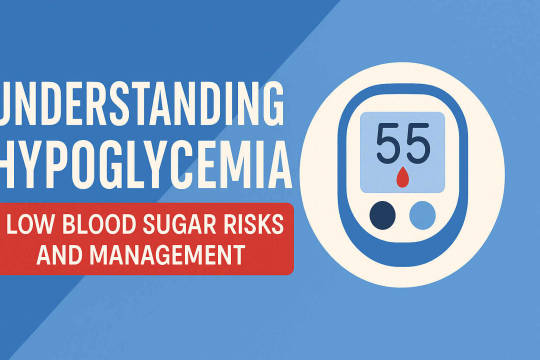
What is Hypoglycemia?
Hypoglycemia is typically defined as a blood glucose level below 70 mg/dL. The body needs glucose as its primary energy source, and when levels fall too low, it can affect brain function and overall physical performance.
Hypoglycemia is most commonly seen in people with diabetes who are on insulin or certain oral medications. However, it can also occur in non-diabetic individuals under specific conditions like fasting, heavy alcohol consumption, or excessive exercise.
Common Causes of Hypoglycemia
Several factors can trigger a drop in blood sugar levels, including:
Skipping Meals: Missing meals or long gaps between meals can lower glucose levels.
Excessive Insulin: Taking too much insulin or diabetes medication can lead to hypoglycemia.
Intense Physical Activity: Prolonged or strenuous exercise without proper carbohydrate intake can deplete glucose stores.
Alcohol Consumption: Drinking on an empty stomach can cause hypoglycemia, especially in people with diabetes.
Hormonal Disorders: Rarely, conditions like adrenal insufficiency can also contribute to low blood sugar levels.
Symptoms of Hypoglycemia
Recognizing hypoglycemia early is crucial. Common signs and symptoms include:
Shaking or tremors
Sweating
Rapid heartbeat
Dizziness or lightheadedness
Irritability or mood changes
Blurred vision
Fatigue
Hunger
Confusion or difficulty concentrating
In severe cases, hypoglycemia can lead to seizures, unconsciousness, or even coma.
Risks Associated with Hypoglycemia
If left unmanaged, hypoglycemia can have serious consequences:
Cognitive Impairment: The brain relies heavily on glucose. Severe hypoglycemia can cause memory loss and coordination issues.
Accidents: Low blood sugar can impair judgment and reaction time, increasing the risk of falls or accidents.
Seizures and Coma: Extremely low glucose levels can lead to life-threatening conditions.
Cardiovascular Stress: Rapid heartbeat and low sugar can strain the heart, especially in older adults.
This makes it essential to have a reliable diabetes management plan, personalized diet, and constant monitoring under the supervision of a specialist like Namita Nadar, the Best Dietician for Diabetes Management in Noida.
How to Prevent and Manage Hypoglycemia
1. Follow a Structured Meal Plan
Eating regular, balanced meals is one of the most effective ways to prevent low blood sugar episodes. Namita Nadar, a top diabetes dietician in Noida, can help design customized meal plans that stabilize blood sugar levels throughout the day.
2. Monitor Blood Sugar Regularly
Frequent monitoring helps you detect drops in blood glucose levels early. It's important to check sugar levels before and after meals, exercise, and whenever you feel unusual symptoms.
3. Carry Fast-Acting Carbohydrates
Always have quick sources of glucose handy, such as:
Glucose tablets
Fruit juice
Sugar candies
If you experience hypoglycemia, consuming 15-20 grams of fast-acting carbs can quickly restore glucose levels.
4. Adjust Medication Dosage
Work closely with your doctor to fine-tune your insulin or diabetes medication doses, especially when your physical activity or dietary patterns change.
5. Plan Exercise Carefully
Physical activity is essential for diabetes management but must be balanced with proper carbohydrate intake. Consult with a dietician like Namita Nadar, the Best Dietician for Diabetes Management in Noida, to create exercise and snack plans that prevent post-workout hypoglycemia.
6. Limit Alcohol Consumption
Drink alcohol in moderation and always consume it with food to prevent delayed hypoglycemia.
7. Educate Family and Friends
Those around you should be able to recognize hypoglycemia symptoms and know how to respond, especially if an emergency arises.
Why Consulting a Dietician is Key
Managing hypoglycemia effectively is not just about medication—diet plays a central role. Personalized diet plans, portion control, proper meal timing, and balanced macronutrient intake can significantly reduce the frequency of low blood sugar episodes.
Namita Nadar, widely recognized as the Best Dietician for Diabetes Management in Noida, provides tailored diabetes diets that help patients:
Maintain steady blood sugar levels
Avoid dangerous sugar drops
Achieve overall better diabetes control
Improve quality of life
Her scientific, practical, and patient-centric approach has helped countless individuals in Noida and beyond manage diabetes safely and effectively.
Conclusion
Hypoglycemia is a potentially dangerous but highly manageable condition when addressed with timely intervention, proper lifestyle adjustments, and professional guidance. Choosing the right dietician, like Namita Nadar, the Best Dietician for Diabetes Management in Noida, can make a significant difference in how well you manage your blood sugar and avoid hypoglycemia risks.
If you or someone you know is living with diabetes, don’t ignore the warning signs of low blood sugar. Prioritize regular check-ups, stay informed, and follow a balanced, customized diet plan for safe and effective diabetes management.
1 note
·
View note
Text
Hmm, I’m under the impression that blood may be unhealthy in other ways. Let’s go through it together, I might be wrong. (Spoiler- I’m wrong)
so, blood, although high in protein, also contains fat and sugar. I did some maths, and was surprised that this is less than I thought (for both numbers I’m using the top of the ‘normal amount in humans’ range, so understand that based on your blood supplier numbers may vary)
Alright, so first is fat, which in blood is 1.5g per litre as opposed to 1-3g per litre in protein shakes, depending on what kind you buy. So, although blood isn’t bad on the fat scale, you can get less fatty alternatives if you choose the protein shake carefully.
I was surprised at the numbers for sugar, however, because we hear a lot about blood sugar, but actually there’s only 1.1g per litre! Now, protein shake numbers vary a lot, but the first result google gave me is around 6g in your average litre of protein shake, so blood is exponentially healthier.
finally, calories. Calories is known to be another ‘ahh, this is unhealthy’ word, but remember that having high calorie food is important if you plan to work out, and blood has 700 calories per litre, with a regular protein shake trailing behind with only 360 calories. To burn off 700 calories you only need to either jog for an hour (at around 5mph) or run at 11mph for half an hour. For reference, at 11mph you would complete the 100m sprint in 20 seconds, which is a fast pace to keep for half an hour. But the jog is definitely possible, considering how 5mph is the average jogging speed.
in conclusion, blood is healthier than a protein shake in pretty much every way, but for those of you who think that you should also transfer to blood-based exercise, please keep in mind that blood is very prone to carrying diseases, especially if not collected and distributed professionally, so be sure to check where you source your blood from. Happy exercising!
Apparently human blood has about the same amount of protein as the average protein shake. You just met Dracula at the local gym and he. is. absolutely. ripped.
#I spent so long on this#brain rotting#maths#mathblr#science side of tumblr#writers#writers on tumblr#writing prompts#writeblr#writing inspiration#so many tabs open#So much googling#so dead#I worked it out so you don’t have to#Also if my maths is wrong let me know I’m a bit of an idiot#Tell me more things that I should also work out so it’s longer with more information
24K notes
·
View notes
Text
Discover the Power of a Full Body Blood Test with Starimaging
In today’s fast-paced world, maintaining good health often takes a backseat to our busy routines. However, regular health checkups are crucial for detecting problems early and managing overall wellness. Among the most essential tools for monitoring health is the full body blood test. It offers a comprehensive overview of your internal health, flagging potential concerns before symptoms even appear. At Starimaging, we believe in empowering individuals with preventive diagnostics that pave the way for a healthier future.

What Is a Full Body Blood Test?
A full body blood test is a broad-spectrum diagnostic assessment that evaluates the functioning of key organs and systems in the body. It includes a combination of tests that check for blood sugar levels, cholesterol, liver and kidney function, thyroid health, complete blood count (CBC), vitamin deficiencies, and more. The goal is to identify hidden health issues, assess nutritional balance, and detect any abnormal changes in the body’s physiology.
Unlike a targeted blood test that focuses on a specific concern, a full body blood test provides a 360-degree view of your health. Whether you're experiencing general fatigue, stress, weight gain, or no symptoms at all, this test can help paint a clear picture of what’s happening inside your body.
Why Should You Consider a Full Body Blood Test?
Early Detection of Diseases Many serious conditions such as diabetes, liver disease, high cholesterol, thyroid disorders, and even some cancers may develop silently. A full body blood test enables early detection, increasing the chances of successful treatment and better outcomes.
Monitoring Existing Conditions If you're already managing a health issue like hypertension, diabetes, or thyroid imbalance, regular testing is vital. These tests allow healthcare providers to monitor how well treatments are working and make timely adjustments when necessary.
Tracking Lifestyle Impact Your lifestyle—diet, exercise, sleep, and stress—can significantly affect your internal health. Routine blood testing can reveal whether your habits are beneficial or harmful, helping you make informed lifestyle changes.
Customized Health Plans With insights from your full body blood test, doctors can personalize your health plan. This may include diet modifications, supplementation, or preventive measures tailored specifically for your body’s needs.
Peace of Mind Knowing that your health is being monitored can relieve anxiety and encourage a proactive approach to wellness. Even if results are within normal ranges, a full body check-up provides reassurance and a baseline for future comparison.
What Does a Full Body Blood Test Typically Include?
Though the exact composition may vary, a typical full body blood test at Starimaging includes:
Complete Blood Count (CBC): Evaluates red cells, white cells, hemoglobin, and platelets to detect conditions like anemia and infections.
Liver Function Tests (LFT): Measures enzymes and proteins in the blood to assess liver health.
Kidney Function Tests (KFT): Checks levels of urea, creatinine, and electrolytes to determine how well your kidneys are filtering waste.
Lipid Profile: Assesses cholesterol and triglyceride levels, which are crucial indicators of heart health.
Thyroid Profile (T3, T4, TSH): Evaluates thyroid hormone levels for detecting hyperthyroidism or hypothyroidism.
Blood Glucose Test: Measures blood sugar levels to identify or monitor diabetes.
Vitamin D and Vitamin B12 Levels: Essential for bone health, energy levels, and nerve function.
Iron Studies: Checks for iron deficiency or overload.
Inflammatory Markers (CRP, ESR): Identifies underlying inflammation that might indicate infection or chronic disease.
At Starimaging, we ensure that all tests are conducted using advanced technology and handled by trained professionals to guarantee accuracy, efficiency, and patient comfort.
When Should You Get a Full Body Blood Test?
If you have a family history of chronic conditions such as diabetes or heart disease
If you're over 30 and have never had a comprehensive health screening
If you experience symptoms like persistent fatigue, unexplained weight changes, or frequent infections
If you're planning a major lifestyle change such as starting a new fitness regime
As part of your annual or biannual preventive health check-up
Health experts recommend undergoing a full body blood test at least once a year, or more frequently if recommended by your physician based on existing medical conditions or risk factors.
Choosing Starimaging for Your Health Needs
Starimaging is a trusted name in diagnostic healthcare, known for offering state-of-the-art facilities and a patient-first approach. Here’s why choosing us for your full body blood test is a smart decision:
Comprehensive Packages: We offer all-inclusive test panels that cover every aspect of your health in one visit.
Expert Consultation: Our experienced medical team guides you through the test reports, helping you understand the findings clearly.
Fast Turnaround Time: With digital report delivery and efficient processes, you receive your results promptly.
Comfortable Environment: Clean, hygienic, and welcoming centers make your testing experience hassle-free.
Personalized Support: Whether you’re visiting for the first time or as a follow-up, our team ensures you get personalized care every step of the way.
A Step Towards Smarter Health Management
Today, proactive health care is not a luxury—it’s a necessity. Taking a full body blood test is one of the most effective ways to stay informed about your body’s current state and prepare for the future. By detecting issues before they become serious, you’re not only safeguarding your health but also reducing long-term medical expenses and improving your quality of life.
At Starimaging, we’re committed to helping you stay a step ahead in your health journey. Our advanced diagnostic solutions and patient-centric services ensure that you receive the highest standard of care at every visit. Whether you’re looking to take preventive measures or understand specific symptoms better, a full body blood test is your gateway to clarity and control.
Take charge of your health today—because when you understand your body, you can take better care of it. Choose Starimaging for a reliable and comprehensive full body diagnostic experience.
0 notes
Text
Can a Diabetes Doctor Help You Reverse Type 2 Diabetes?

If you’ve been told that Type 2 diabetes is a “lifelong condition,” you might be surprised to know — that’s not always true.
With the right approach, many people have actually reversed their Type 2 diabetes. But the key? You need proper guidance — and that’s where a diabetes doctor (diabetologist) plays a major role.
Let’s break down how it works.
What Does “Reversing” Diabetes Even Mean?
Reversal doesn’t mean you’re cured forever. It means your blood sugar levels stay in the normal range without medication — through lifestyle, diet, and weight loss.
Think of it like putting your diabetes into “remission.”
How a Diabetes Doctor Helps You Get There
Here’s how a specialist can make a huge difference compared to general advice from the internet or your regular doctor:
✅ 1. Personalized Plans
No two diabetic bodies are the same. A diabetes doctor studies your:
Bloodwork
Medication history
Lifestyle
Complications (like foot issues or fatigue)
And then creates a custom plan that actually works for YOU.
✅ 2. Targeted Diet & Exercise Guidance
Reversal isn’t just about cutting sugar. It's about the right carb balance, activity timing, and even meal scheduling. Your specialist ensures it's doable and sustainable.
👣 Need help with lifestyle changes? Read this: Exercise Safety Tips for Diabetic Patients
✅ 3. Safe Medication Tapering
You shouldn’t just stop meds suddenly. A diabetologist slowly reduces your dosage based on your progress — avoiding crashes or dangerous sugar spikes.
✅ 4. Weight Management Help
If you’re overweight, losing even 5–10% of your body weight can reverse diabetes. Your specialist may recommend:
Nutrition tweaks
Safe fasting routines
Natural fat-loss programs
🍲 Try this too: Natural Home Remedies for Managing Diabetes
🔁 Realistic? Yes. Easy? No. Worth It? Absolutely.
Type 2 diabetes reversal takes:
Discipline
Tracking
Support
Follow-ups
But here’s the thing: You don’t have to do it alone. With the right doctor by your side, it becomes a guided, safe journey — not a guessing game.
Final Thoughts: Your Diabetes Isn’t a Life Sentence
You have the power to take back control of your sugar levels — but don’t rely on guesswork or TikTok hacks. A qualified diabetes doctor can walk with you step-by-step through real, science-backed reversal.
Ready to Take the First Step?
Whether you’re newly diagnosed or tired of taking meds every day, it’s never too late to make a change.
📞 Book your consultation today with Dr. Durai’s Diabetic Care — and let’s create your personalized reversal plan together.
1 note
·
View note
Text
Prediabetes Market Scope, Growth Driver and Future Business Opportunities 2034

Prediabetes is a medical condition in which blood sugar levels are elevated above the normal range but not high enough to be classified as type 2 diabetes. Fasting blood glucose levels typically range from 100 to 125 mg/dL in individuals with prediabetes. This condition suggests early issues with blood sugar regulation, often resulting from insulin resistance. Although prediabetes usually presents without clear symptoms, it greatly increases the risk of progressing to type 2 diabetes, as well as developing cardiovascular diseases and stroke if not properly managed. However, adopting healthier lifestyle habits—such as a balanced diet, regular physical activity, and maintaining a healthy weight—can effectively prevent or delay its progression.
According to SPER market research, ‘Global Prediabetes Market Size- By Drug Class, By Age Group - Regional Outlook, Competitive Strategies and Segment Forecast to 2034’ state that the Global Prediabetes Market is predicted to reach 1021.93 million by 2034 with a CAGR of 11.19%.
Drivers:
The prediabetes market is witnessing consistent growth, fueled by a combination of contributing factors. A major driver is the global increase in obesity and physical inactivity, both of which elevate the risk of developing prediabetes. The aging population and rapid urbanization are also leading to a higher incidence of the condition. Furthermore, enhanced healthcare accessibility and rising awareness of the serious health risks linked to untreated prediabetes—such as type 2 diabetes and heart disease—are prompting more individuals to undergo screening and begin early treatment. The growing adoption of effective medications like Metformin and GLP-1 receptor agonists is also broadening the range of available treatment options.
Request a Free Sample Report: https://www.sperresearch.com/report-store/prediabetes-market?sample=1
Restraints:
The global prediabetes market faces a number of obstacles that limit its overall growth. A key issue is the high rate of underdiagnosis, as prediabetes often lacks noticeable symptoms, leaving many individuals unaware they are affected. This is further exacerbated by low public awareness and inadequate routine screening, especially in low-resource and developing regions. Inequities in access to healthcare, diagnostic technologies, and regular monitoring contribute to inconsistent detection and treatment worldwide. Moreover, most current treatments are repurposed from type 2 diabetes therapies, with few drugs specifically approved for prediabetes, reducing the availability of targeted treatment options.
In 2024, North America dominated the prediabetes market, largely due to the rising use of GLP-1 agonists and an increased emphasis on personalized treatment approaches. GLP-1 agonists have gained popularity for their proven ability to regulate blood sugar and support weight loss, making them a preferred option in prediabetes care. Additionally, the expanding adoption of personalized medicine—tailoring treatments based on an individual's genetic profile and lifestyle—has enhanced the effectiveness of interventions. These developments have significantly improved prediabetes management and fueled market growth across the region. Some significant market players are Boston Pharmaceuticals, APHAIA PHARMA AG, AstraZeneca, Bristol-Myers Squibb Company, Pfizer Inc.
For More Information, refer to below link: –
Prediabetes Market Growth
Related Reports:
Global Intravenous Immunoglobulin Market Size
Global Veterinary Eye Care Market Growth
Follow Us –
LinkedIn | Instagram | Facebook | Twitter
Contact Us:
Sara Lopes, Business Consultant — USA
SPER Market Research
+1–347–460–2899
#Prediabetes Market#Prediabetes Market Share#Prediabetes Market Size#Prediabetes Market Revenue#Prediabetes Market Analysis#Prediabetes Market Segmentation#Prediabetes Market Future Outlook#Prediabetes Market Competition#Prediabetes Market forecast
0 notes